|
|
Post by zarahan on Jun 29, 2015 13:40:07 GMT -5
New DNA data suggests that many modern Egyptians are not identical to the ancient Egyptians. While there is some linkage among SOME of today's Egyptians, particularly particularly in the tropical south, from whence the Dynasties sprung, new data indicates that many Egyptians today are Arabized/Eurasian types or hybrids. This is not necessarily a new finding. Bone studies show that the very late period Egyptians (600-350BC) have datasets that are not "typically" Egyptians, like the earlier tropical African types before. Still, especially in the south, the tropical African influence still shows. Note this is not an "either/or"
situation- but a matter of degree. MOST modern Egyptians seem Arabized/Eurasian
but the DNA data still shows about one-third African, even with the Arabized
takeover of Egypt. Below is a roundup:
------------------------------------------------------------------------
----> FOX - COMAS - SANCHEZ-QUINTO

![]() i58.tinypic.com/2nle1yc.jpg/IMG] i58.tinypic.com/2nle1yc.jpg/IMG]
-----> Ennafaa's (2011, Fregel) sANCHEZ-qUINTO
here are TS5 & TS6 with Morocco, Tunisia, Libya, and Egypt population frequencies for select mtDNA & nrY Hgs.



Out of Ennafaa's selected African samples
* Egypt is not primarily African
[*]

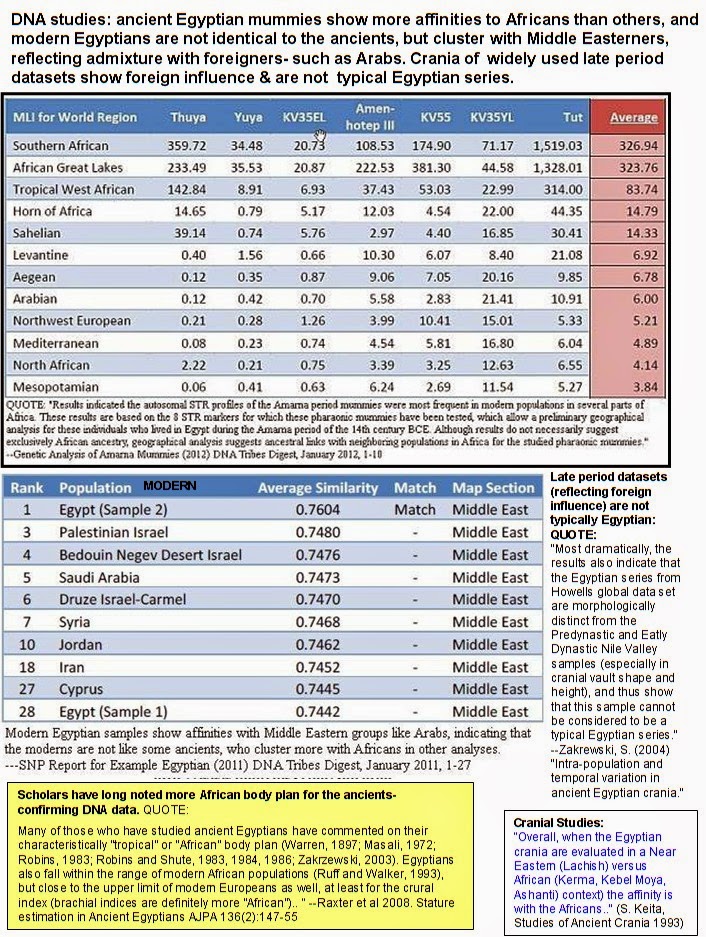
--------------------------------------------------------------------------------------------------
As expected, because of the Arab conquest and conquests by Persians,
Assyrians, Greeks, Romans, etc plus modern migration from Palestine
and other parts of the "Middle East" the African component today would
not be as strong- but it is still there, contradicting attempts by some
modern types to "cleanse" the African elements,or make out that everything
African today in Egypt is "foreign." This is not so. There is plenty of
African influence in Egypt even today. But today's MAJORITY is no longer
African. The Arabized/Eurasiatic types PREDOMINATE today. They are not
the full picture.
Again note, this does not mean that some links and holdovers are not in
Egypt today, but they are a minority, compared to the Arab dominance.
And again- just to be clear - there is still indigenous African influence in
Egypt today- the Nubians for example have not gone anywhere, nor have the many
interchanges with the Sudan.
-----------------------------------------------------------------------------------------

quote:
"The data consist of 55 cranio-facial variables
from 418 adult Egyptian individuals,
from six periods, ranging in date from
c. 5000 to 1200 BC. These were compared
with the 111 Late Period crania (c. 600-
350 BC) from the Howells sample. Principal
Component and Canonical Discriminant
Function Analyses were undertaken,
on both pooled and single sex samples.
The results suggest a level of local population
continuity exists within the earlier
Egyptian populations, but that this was in
association with some change in population
structure, reflecting small-scale immigration
and admixture with new
groups. Most dramatically, the results
also indicate that the Egyptian series
from Howells global data set are morphologically
distinct from the Predynastic and
Early Dynastic Nile Valley samples (especially
in cranial vault shape and height),
and thus show that this sample cannot be
----Zakrewski, S. (2004) "Intra-population and temporal variation in
ancient Egyptian crania.
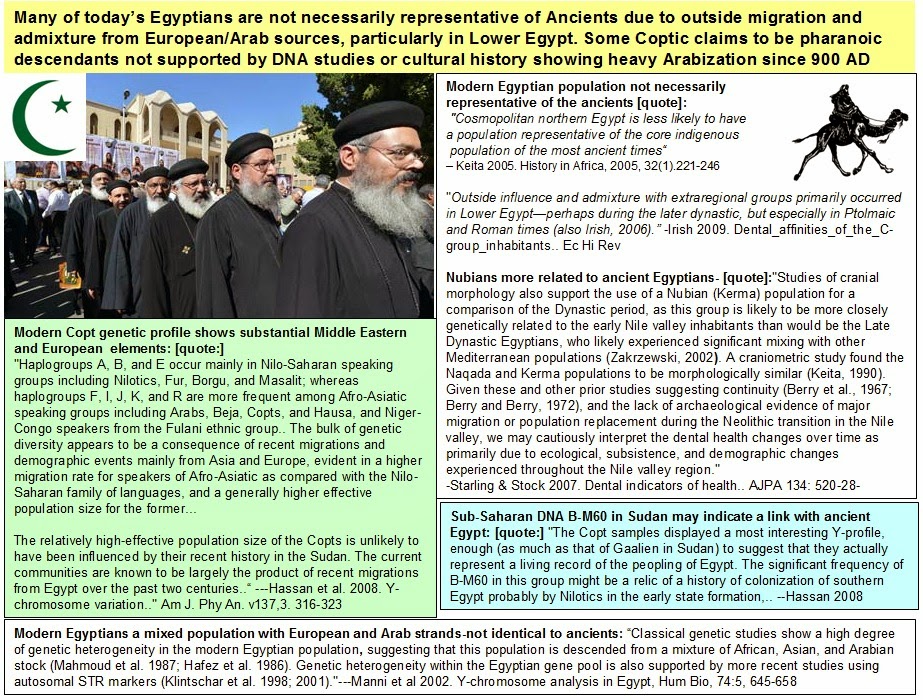 Many of today’s Egyptians are not necessarily representative of Ancients due to outside migration and admixture from European/Arab sources, particularly in Lower Egypt. Some Coptic claims to be pharanoic descendants not supported by DNA studies or cultural history showing heavy Arabization since 900 AD Modern Copt genetic profile shows substantial Middle Eastern and European elements: [quote:] Many of today’s Egyptians are not necessarily representative of Ancients due to outside migration and admixture from European/Arab sources, particularly in Lower Egypt. Some Coptic claims to be pharanoic descendants not supported by DNA studies or cultural history showing heavy Arabization since 900 AD Modern Copt genetic profile shows substantial Middle Eastern and European elements: [quote:] "Haplogroups A, B, and E occur mainly in Nilo-Saharan speaking groups including Nilotics, Fur, Borgu, and Masalit; whereas haplogroups F, I, J, K, and R are more frequent among Afro-Asiatic speaking groups including Arabs, Beja, Copts, and Hausa, and Niger-Congo speakers from the Fulani ethnic group.. The bulk of genetic diversity appears to be a consequence of recent migrations and demographic events mainly from Asia and Europe, evident in a higher migration rate for speakers of Afro-Asiatic as compared with the Nilo-Saharan family of languages, and a generally higher effective population size for the former... The relatively high-effective population size of the Copts is unlikely to have been influenced by their recent history in the Sudan. The current communities are known to be largely the product of recent migrations from Egypt over the past two centuries..“ ---Hassan et al. 2008. Y-chromosome variation.." Am J. Phy An. v137,3. 316-323 Sub-Saharan DNA B-M60 in Sudan may indicate a link with ancient Egypt: [quote:] "The Copt samples displayed a most interesting Y-profile, enough (as much as that of Gaalien in Sudan) to suggest that they actually represent a living record of the peopling of Egypt. The significant frequency of B-M60 in this group might be a relic of a history of colonization of southern Egypt probably by Nilotics in the early state formation,.. --Hassan 2008 Modern Egyptian population not necessarily representative of the ancients "Cosmopolitan northern Egypt is less likely to have a population representative of the core indigenous population of the most ancient times“ – Keita 2005. History in Africa, 2005, 32(1).221-246 "Outside influence and admixture with extraregional groups primarily occurred in Lower Egypt—perhaps during the later dynastic, but especially in Ptolmaic and Roman times (also Irish, 2006).” -Irish 2009. Dental_affinities_of_the_C-group_inhabitants.. Ec Hi Rev Nubians more related to ancient Egyptians- "Studies of cranial morphology also support the use of a Nubian (Kerma) population for a comparison of the Dynastic period, as this group is likely to be more closely genetically related to the early Nile valley inhabitants than would be the Late Dynastic Egyptians, who likely experienced significant mixing with other Mediterranean populations (Zakrzewski, 2002). A craniometric study found the Naqada and Kerma populations to be morphologically similar (Keita, 1990). Given these and other prior studies suggesting continuity (Berry et al., 1967; Berry and Berry, 1972), and the lack of archaeological evidence of major migration or population replacement during the Neolithic transition in the Nile valley, we may cautiously interpret the dental health changes over time as primarily due to ecological, subsistence, and demographic changes experienced throughout the Nile valley region." -Starling & Stock 2007. Dental indicators of health.. AJPA 134: 520-28- Modern Egyptians a mixed population with European and Arab strands-not identical to ancients: “Classical genetic studies show a high degree of genetic heterogeneity in the modern Egyptian population, suggesting that this population is descended from a mixture of African, Asian, and Arabian stock (Mahmoud et al. 1987; Hafez et al. 1986). Genetic heterogeneity within the Egyptian gene pool is also supported by more recent studies using autosomal STR markers (Klintschar et al. 1998; 2001)." ---Manni et al 2002. Y-chromosome analysis in Egypt, Hum Bio, 74:5, 645-658 Their overlap with other Egyptian samples (in PC space, Fig. 2) suggests that although their morphology is distinctive, the pattern does overlap with the other time periods. These results therefore do not support the Petrie concept of a \Dynastic race" (Petrie, 1939; Derry, 1956). Instead, the results suggest that the Egyptian state was not the product of mass movement of populations into the Egyptian Nile region, but rather that it was the result of primarily indigenous development combined with prolonged small-scale migration, potentially from trade, military, or other contacts. --Sonia R. Zakrzewski (2007) "It is often assumed that Egyptian writing was invented under a stimulus of the Mesopotamian writing system, developed in the late fourth millennium BC, that might have come at the time of the short-lived Uruk Culture expansion into Syria. A variety of artistic and architectural evidence for contact between Mesopotamia and late Predynastic Egypt has been found, but none of it can be dated precisely in relation to Tomb U-j. Moreover, **the Egyptian writing system is different from the Mesopotamian and must have been developed independently.** The possibility of “stimulus diffusion” from Mesopotamia remains, but the influence **cannot have gone beyond the transmission of an idea.** A second point *of contrast with Mesopotamia* is in uses of writing. The earliest Egyptian writing consists of inscribed tags, ink notations on pottery, again principally from the royal cemetery at Abydos, and hieroglyphs incorporated into artistic compositions, of which the chief clear examples are such pieces as the *Narmer Palette,* which is probably more than a century later than Tomb U-j. Thus, while administrative uses of writing appear to have come at the beginning—examples from the Abydos tombs include such notations as “produce of Lower Egypt”—the system was integrated fully into pictorial representation. An intermediate, emblematic mode of representation in which symbols, including hieroglyphs, were shown in action also evolved before the 1st Dynasty. These three modes together formed a powerful artistic complex that endured as long as Egyptian civilization." --Encyclopedia of the Archaeology of Ancient Egypt, ed. Kathryn A. Bard and Steven Blake Shubert, ( London and New York: Routledge, 1999) 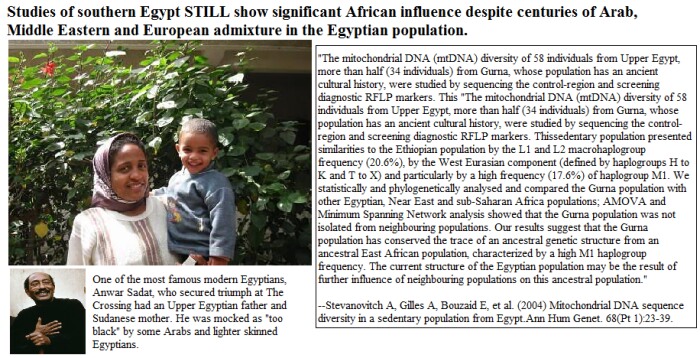 |
|
|
|
Post by zarahan on Jun 29, 2015 13:42:48 GMT -5
Non-African ancestry in Egyptians traced to Islamic invasions and expansions
"Using ADMIXTURE and principal-component analysis (PCA) (Figure 1A),
we estimated the average proportion of non-African ancestry in the Egyptians
to be 80% and dated the midpoint of the admixture event by using ALDER20 to
around 750 years ago (Table S2), consistent with the Islamic expansion and dates
reported previously. "
-- Luca Pagani et al. 2015. Tracing the Route of Modern Humans out of Africa by Using 225
Human Genome Sequences from Ethiopians and Egyptians. e American Journal of Human Genetics.
American Journal of Human Genetics, Volume 96, Issue 6, p986–991,
|
|
|
|
Post by zarahan on Aug 3, 2015 12:26:14 GMT -5
"It can be noted that none of the Northeast African groups are significantly different from any other African groups (East African (EA), African Pygmy (AP), Khoe-San (KS)) (Table 27). 156 Therefore, West Africans of both sexes appear to possess the longest distal bones relative to the proximal for the upper limb. Ancient Egyptians and Nubians thus possess generally tropically adapted upper limb proportions, with their brachial indices grouping with the majority of other African groups."
"Ancient Egyptians and Nubians of both sexes are consistently significantly different in limb length proportions from Northern and Southern Europeans, with their brachial and crural indices grouping with the majority of other Africans."
--Raxter Michele, 2011. Egyptian Body Size: A Regional and Worldwide Comparison by Raxter. Published Thesis, 2011. University of South Florida 2011.
|
|
|
|
Post by zarahan on Sept 5, 2015 18:41:32 GMT -5
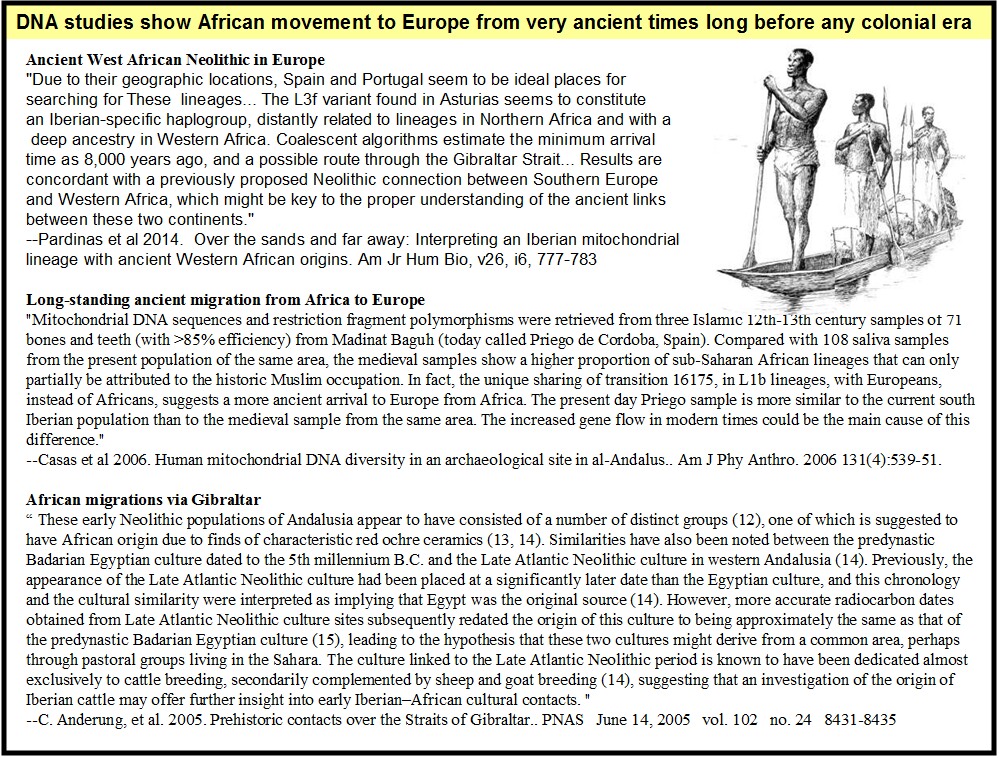 Ancient West African Neolithic in Europe Ancient West African Neolithic in Europe"Due to their geographic locations, Spain and Portugal seem to be ideal places for searching for These lineages... The L3f variant found in Asturias seems to constitute an Iberian-specific haplogroup, distantly related to lineages in Northern Africa and with a deep ancestry in Western Africa. Coalescent algorithms estimate the minimum arrival time as 8,000 years ago, and a possible route through the Gibraltar Strait... Results are concordant with a previously proposed Neolithic connection between Southern Europe and Western Africa, which might be key to the proper understanding of the ancient links between these two continents." --Pardinas et al 2014. Over the sands and far away: Interpreting an Iberian mitochondrial lineage with ancient Western African origins. Am Jr Hum Bio, v26, i6, 777-783 Long-standing ancient migration from Africa to Europe"Mitochondrial DNA sequences and restriction fragment polymorphisms were retrieved from three Islamic 12th-13th century samples of 71 bones and teeth (with >85% efficiency) from Madinat Baguh (today called Priego de Cordoba, Spain). Compared with 108 saliva samples from the present population of the same area, the medieval samples show a higher proportion of sub-Saharan African lineages that can only partially be attributed to the historic Muslim occupation. In fact, the unique sharing of transition 16175, in L1b lineages, with Europeans, instead of Africans, suggests a more ancient arrival to Europe from Africa. The present day Priego sample is more similar to the current south Iberian population than to the medieval sample from the same area. The increased gene flow in modern times could be the main cause of this difference." --Casas et al 2006. Human mitochondrial DNA diversity in an archaeological site in al-Andalus.. Am J Phy Anthro. 2006 131(4):539-51. African migrations via Gibraltar“ These early Neolithic populations of Andalusia appear to have consisted of a number of distinct groups (12), one of which is suggested to have African origin due to finds of characteristic red ochre ceramics (13, 14). Similarities have also been noted between the predynastic Badarian Egyptian culture dated to the 5th millennium B.C. and the Late Atlantic Neolithic culture in western Andalusia (14). Previously, the appearance of the Late Atlantic Neolithic culture had been placed at a significantly later date than the Egyptian culture, and this chronology and the cultural similarity were interpreted as implying that Egypt was the original source (14). However, more accurate radiocarbon dates obtained from Late Atlantic Neolithic culture sites subsequently redated the origin of this culture to being approximately the same as that of the predynastic Badarian Egyptian culture (15), leading to the hypothesis that these two cultures might derive from a common area, perhaps through pastoral groups living in the Sahara. The culture linked to the Late Atlantic Neolithic period is known to have been dedicated almost exclusively to cattle breeding, secondarily complemented by sheep and goat breeding (14), suggesting that an investigation of the origin of Iberian cattle may offer further insight into early Iberian–African cultural contacts. " --C. Anderung, et al. 2005. Prehistoric contacts over the Straits of Gibraltar.. PNAS June 14, 2005 vol. 102 no. 24 8431-8435 |
|
|
|
Post by zarahan on Sept 5, 2015 19:42:18 GMT -5
:format(jpeg):mode_rgb()/discogs-images/R-766835-1160674026.jpeg.jpg) DNA studies show that light skin in Europe only occurred recently DNA studies show that light skin in Europe only occurred recently"SLC24A5 was shown to play a pivotal role in skin pigmentation lightening in Europeans 10. Interestingly, the haplotype profile of SLC24A5 in CEU revealed a high affinity to aFM ( D aFM, MHG = 2) and a substantial distance to aHG ( D aHG, MHG = 28), as suggests that skin lightening associated with SLC24A5 originated from Near East, and likely was introduced into ancient Europeans via farming transition. This was strongly supported by a recent study based on 83 ancient DNA specimens 53." --Zhou et al 2015 (A Chronological Atlas of Natural Selection in the Human Genome during the Past Half-million Years. BioRxiv (quoted in Cochran). "We also found evidence of selection at two loci that affect skin pigmentation. The derived alleles 63 of rs1426654 at SLC24A5 and rs16891982 at SLC45A2 are, respectively, fixed and almost fixed in present -64 day Europeans 23,24. As previously reported 7,11,12, both derived alleles are absent or very rare in western 65 hunter -gatherers. suggesting that mainland European hunter -gatherers may have had dark skin 66 pigmentation. SLC45A2 first appears in our data at low frequency in the Early Neolithic, and increases 67 steadily in frequency until the present... In contrast, the derived allele of 69 SLC24A5 increases rapidly in frequency to around 0.9 in the Early Neolithic, suggesting that most of the 70 increase in frequency of this allele is due to its high frequency in the early farmers who migrated from the southeast at this time, although there is still strong evidence of ongoing selection after the arrival 72 of farming .." --Mathieson et al 2015. Eight thousand years of natural selection in Europe. bioRxiv 2015. Even as late as the Mesolithic, on several counts European skin was not white<blockquote> " Our results indicate that the adaptive spread of light skin pigmentation alleles was not complete in some European populations by the Mesolithic, and that the spread of alleles associated with light/blue eye colour may have preceded changes in skin pigmentation... With respect to two recent well-studied adaptations to changes in diet, we found the ancient genome to carry the ancestral allele for lactose intolerance.. These results suggest the La Brana hunter-gatherer was poor at digesting milk and starch, supporting the hypotheses that these abilities were selected for during the later transition to agriculture." --Olalde, Inigo, et al. "Derived immune and ancestral pigmentation alleles in a 7,000-year-old Mesolithic European." Nature 507.7491 (2014) </blockquote> |
|
|
|
Post by zarahan on Sept 7, 2015 20:38:05 GMT -5
 The internal flow.. from Africa.. DNA study casts doubt on some claimed levels of back-migration from Asia
to Africa for all variants of R1b. The V88 DNA marker claimed to have "back-flowed"
solely from Eurasia is better explained by migration from the South, WITHIN
AfricaQUOTE: "Human Y chromosomes belonging to the haplogroup R1b1-P25, although very common in Europe, are usually rare in Africa. However, recently published studies have reported high frequencies of this haplogroup in the central-western region of the African continent and proposed that this represents a 'back-to-Africa' migration during prehistoric times. To obtain a deeper insight into the history of these lineages, we characterised the paternal genetic background of a population in Equatorial Guinea, a Central-West African country located near the region in which the highest frequencies of the R1b1 haplogroup in Africa have been found to date. In our sample, the large majority (78.6%) of the sequences belong to subclades in haplogroup E, which are the most frequent in Bantu groups. However, the frequency of the R1b1 haplogroup in our sample (17.0%) was higher than that previously observed for the majority of the African continent. Of these R1b1 samples, nine are defined by the V88 marker, which was recently discovered in Africa. As high microsatellite variance was found inside this haplogroup in Central-West Africa and a decrease in this variance was observed towards Northeast Africa, our findings do not support the previously hypothesised movement of Chadic-speaking people from the North across the Sahara as the explanation for these R1b1 lineages in Central-West Africa. The present findings are also compatible with an origin of the V88-derived allele in the Central-West Africa, and its presence in North Africa may be better explained as the result of a migration from the south during the mid-Holocene." --Gonzalez et al 2013. The genetic landscape of Equatorial Guinea and the origin and migration routes of the Y chromosome haplogroup R-V88. Eur J Hum Genet. 2013 Mar;21(3):324-31. 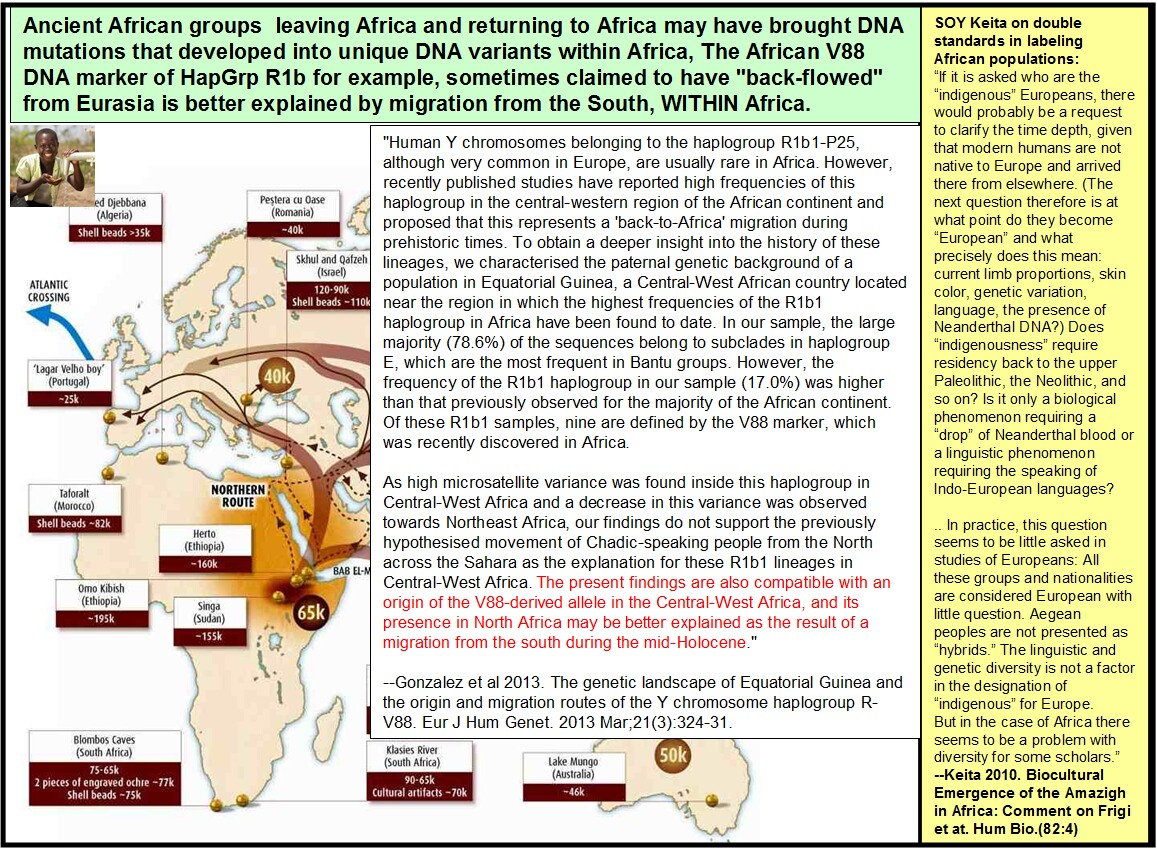 All agree that ancient tribes and groups might have moved back and forth from Africa to Arabia and the Levant and vice versa tens of thousands of years ago. Just nomads can do that easily following herds, or people can move in response to climate changes or food resource fluctuations. But whatever the reason, the peoples shuffling back and forth looked like Africans, no matter what label is put on them.. It makes little difference.. All agree that ancient tribes and groups might have moved back and forth from Africa to Arabia and the Levant and vice versa tens of thousands of years ago. Just nomads can do that easily following herds, or people can move in response to climate changes or food resource fluctuations. But whatever the reason, the peoples shuffling back and forth looked like Africans, no matter what label is put on them.. It makes little difference..  |
|
|
|
Post by zarahan on Sept 18, 2015 22:17:38 GMT -5
So-called “Basal Eurasian” DNA label is based on heavily admixed African types. A 2014 study uses ancient European “Muhlhausen” sample to help define “basal Eurasian”, but this SAME sample groups with Africans per a 2006 crainofacial study. The 2014 study admits that “Basal Eurasian” is closely linked with migration of Africans into areas like the Near east. FROM BRACE 2006- THE QUESTIONABLE CONTRIBUTION..
Stuttgart Mulhausen sample clusters with African types in craniofacial analyses- - Brace 2006 QUOTE: "These non metric attributes all support the view that most of the Neolithic inhabitants of Europe tie more closely together with each other than with the living representatives of the areas in question. The principal exception to this generalization is [...] the Muhlhausen sample, which ties closer metrically to the living inhabitants of the Middle East and North Africa.“ FROM: Brace, et al. The questionable contribution of the Neolithic and the Bronze Age to European craniofacial form, PNAS 2006. January 3; 103(1): p. 242-247. “Basal Eurasian” closer to Africans (Mbuti), African OOA transitional group, (“non-African”) then Early European Farmers (EEF), making up modern European DNA profile in part. QUOTE: “We sequenced genomes from a ~7,000 year old early farmer from Stuttgart in Germany, an ~8,000 year old hunter-gatherer from Luxembourg, and seven ~8,000 year old hunter gatherers from southern Sweden.. The Stuttgart sample was taken from a female skeleton excavated in 1982 at the site Viesenhäuser Hof, Stuttgart-Mühlhausen, Germany. It was attributed to the Linearbandkeramik (5,500-4,800 BC) .. The successful model (Fig. 2A) includes the previously reported gene flow into Native Americans from an MA1-like population6, as well as the novel inference that Stuttgart is partially (44 ± 10%) derived from a “Basal Eurasian” lineage that split prior to the separation of eastern non-Africans from the common ancestor of WHG and ANE…
A Basal Eurasian lineage in the Near East is plausible given the presence of anatomically modern humans in the Levant29 ~100 thousand years ago and African-related tools likely made by modern humans in Arabia30,31. Alternatively, evidence for gene flow between the Near East and Africa32, and African morphology in pre-farming Natufians33 from Israel, may also be consistent with the population representing a later movement of humans out of Africa and into the Near East.” –Lizardis et al 2014. Ancient human genomes suggest three ancestral populations for present-day Europeans. Nature 513, 409–413 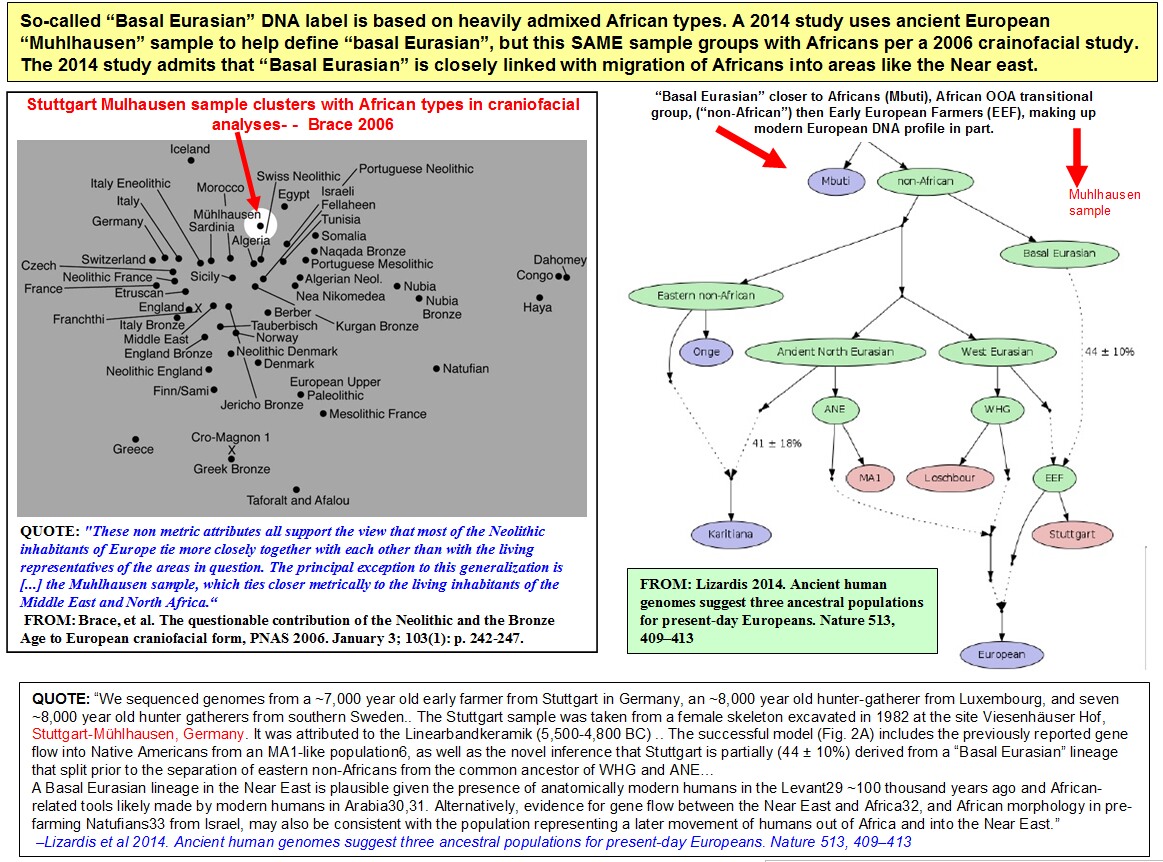
|
|
|
|
Post by zarahan on Oct 3, 2015 0:53:03 GMT -5
Holiday 2010 limb proportion slice- Egyptians group with Kerma [Sudan] West Africa, East Africa, and African Americans. See original study for "Nubian" anomalies and cold climate population comparisons. The "Nubians" sample elsewhere in the study apparently came from Europe or W Asia among other things. Overall results track with other limb proportion studies on Egyptians with Africans being their primary match. _____________________________________________________________________________________________________________________________  |
|
|
|
Post by anansi on Oct 3, 2015 6:45:22 GMT -5
Im not sure I follow this, are they saying that early "Nubian" sample had some cold climate adaptation among them??
|
|
|
|
Post by zarahan on Oct 3, 2015 11:57:38 GMT -5
Im not sure I follow this, are they saying that early "Nubian" sample had some cold climate adaptation among them?? Yeah, its weird. Here is the full diagram below. I wondered at the Nubian position but the authors say the sample could be from somewhere in Europe or SW Asia. COuld be a sample mislabed as "Nubian". The authors themselves note it specifically. It is not merely bloggers somewhere on the Net asking such questions.. 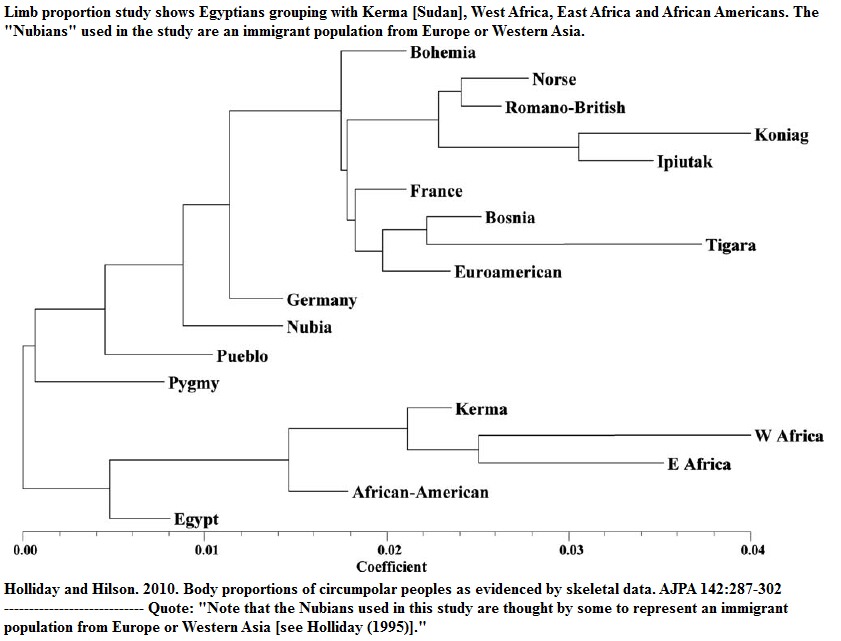 |
|
|
|
Post by zarahan on Oct 3, 2015 12:00:47 GMT -5
Numerous studies of North Africa" use samples dawn near the coast
while excluding much larger inland areas and countries that make up
"North Africa" giving a misleading picture of African diversity in
North Africa." From ES: ----------------------------------------------------------------- Troll Patrol recently posted 2012 comments by Comas saying that "Modern North Africans' recent origin is outside Africa." Comas' write-up plugs in the "North African" picture below, which also appears on Madilda's website. One can readily see the "spin". Very few dark faces are apparently in this version of "North Africa." All too conveniently negro free... Or is it?  Comments: I need to look at the pdf but it seems to me right off the bat that assorted authors do that capture a full snapshot the region "North Africa" but mostly a very selective coastal part. Karima et al 2011 for example use data from mostly coastal samples for "North Africa" covering Coastal Morocco, Algeria, Tunisia, and then Libyan Tuareg, and Northern/Lower Egypt up near the Cairo area. Why didn't they cover southern/Upper Egypt? Thus sweeping claims about "North Africa" can honestly only apply to COASTAL North Africa. What about the rest of the region, like southern Egypt, etc? This is a long-standing issue- how they sample. And once they get the coastal samples to stand in for "North Africa" then they can conveniently juxtapose them against distant "Sub-Saharan" samples somewhere near the Congo. El-Sibai et al 2011 for example use the same "coastal" approach and then compare that to distant Congo, Gabon, Nigeria. But their "Middle Eastern" or "Eurasian" comparison sample is right next door- Syria, Israel, Lebanon. By contrast, they don't use the Sudan right next door to Egypt even though that location is also sometimes classified as "North African" by mainstream geography writings. We have seen this double standard time and time again, and Keita comments on such selective sampling in the scientific literature. It is not merely bloggers noting these discrepancies, some credible mainstream scholars also note the double standards. 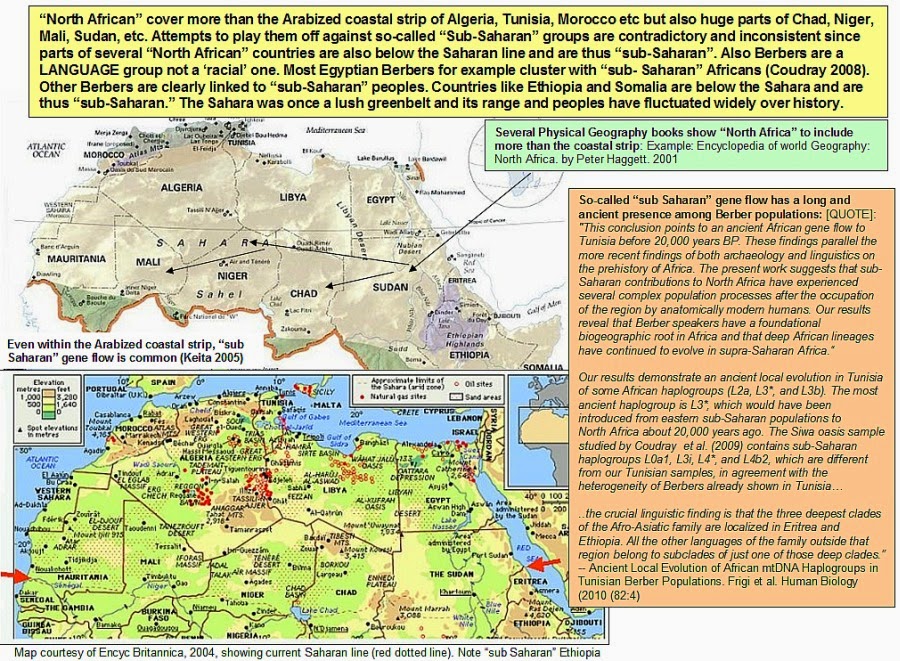 The statement: Modern North Africans' recent origin is outside AfricaIs misleading when the full picture is considered as detailed above. It would be more accurate to say that SOME modern North African's recent origin, using mostly COASTAL sampling, may be outside of Africa. Here are other "North Africans"- that somehow "disappear" in many studies... 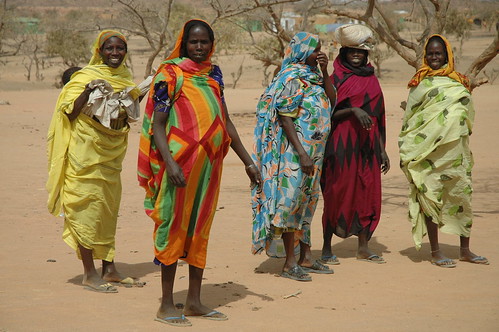 Chad  Sudan  Mali  Niger..  Mauritania The above peoples are all mostly ABOVE the Saharan line. But apparently, they ain't "authentically" North African enough.. Maybe they ain't "really" black...
|
|
|
|
Post by zarahan on Oct 3, 2015 12:32:38 GMT -5
Assorted claimants try to use Southern European crural limb indexes to deAfricanize Egyptians on limb proportions. They fail. Below, African populations can have a range of crural indexes that overlap other populations whether they be in southern Europe or ancient Europe's tropically adapted populations. In diverse Africa, crural limb proportion indexes are also diverse but the people still are African. 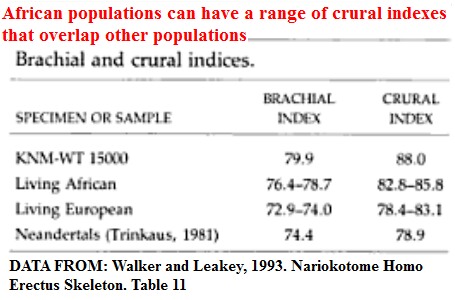 |
|
|
|
Post by zarahan on Oct 11, 2015 21:34:50 GMT -5
THIS ARTICLE CRITIQUES SIMPLISTIC THEMES ABOUT "EGYPTIANIZATION OF NUBIA." NUBIANS WERE NOT SIMPLY
RECEIVERS FROM EGYPT- IT WAS A TWO-WAY STREET, A REALITY OFTEN MISSED BY SCHOLARS AND POPULAR MEDIA
Revising Egypto-Nubian Relations in New Kingdom Lower Nubia: From Egyptianization to Cultural Entanglement
van Pelt, W Paul. Cambridge Archaeological Journal23.3 (Oct 2013): 523-550.
aBSTRACT
Building on recent criticisms of Romanization, this contribution formulates a systematic
critique of the concept of Egyptianization and suggests a different theoretical approach
to cultural process in New Kingdom Nubia that benefits from the insights of ‘cultural
entanglement’. This approach emphasizes multidirectional and interactive perspectives
that allow for a variety of acculturative outcomes rather than one-sided assimilation. A
useful epistemological framework for its application in archaeology is illustrated through
two case studies, focusing respectively on representations of Egyptianized Nubians in
Egyptian art and Lower Nubian burial customs. The outcomes of the case studies argue
for a provocative re-reading of cultural process in New Kingdom Lower Nubia, and may
help to clarify the general picture of Nubian history by explaining why and how Nubian
traits re-appeared in the Napatan-Meroitic Kingdom of Kush. Finally, the article considers
some broader methodological and theoretical issues relating to cultural mixture in the
archaeological record.
Conventional accounts of Egyptian New Kingdom ( c. 1550–1069 bc ) colonialism and its cultural influ -ences in Lower Nubia 1 tell the story of a unidirectional transfer and modification of one set of lifestyles over another. According to these accounts, Lower Nubian styles of administration, material culture, cults and customs were side-lined and eventually completely substituted by Egyptian forms over the course of the New Kingdom. (e.g. Brugsch 1891, 2–3; Reisner 1910, 340–42; 1918, 236–7; Firth 1912, 27; 1915, 20–21; 1927, 25; Griffith 1921, 71; Junker 1925, 37, 43–4; Emery & Kirwan 1935, 4; Säve-Söderbergh 1941, 129–35, 184–90; 1967–1968; 1969, 12–20; Emery 1965, 177–8; Trigger 1976, 110, 131–5; Kemp 1978, 34–5; Leclant 1978, 70; O’Connor 1978, 56; 1982, 910–12; Frandsen 1979, 169–70; Adams 1984, 235; Zibelius-Chen 1988, 63; Smith 1991, 84, 91–4; 1995, 148–54; 1997, 71; 1998, 260, 277–9; 2001a, 156; Taylor 1991, 32–3; Redford 1992, 192; 2004, 44–5; Morris 2005, 96–7). This pattern of cultural change is referred to as ‘Egyptianization’. In the absence of indigenous written records from Nubia, scholarly perceptions of the coloniza -tion of the area have been largely based on Egyptian historical sources. However, the results of archaeo -logical fieldwork in Nubia are increasingly enabling archaeologists to tell the story from a different per -spective. Even though some forays into this research have already suggested that traditional notions of Egyptianization are not appropriate for all contact situations in Nubia (Säve-Söderbergh 1991a; Sinclair & Troy 1991; Cohen 1992; Edwards 2003; Fuller 2003; Smith 2003; Buzon 2006; Török 2009), no one has hith -erto attempted to formulate a systematic critique of the theoretical and ideological foundations of Egyptiani -zation, nor has anyone formally proposed to replace the concept with something more sophisticated. Egyp -tianization therefore still dominates the analysis of cul -tural process and change in Egypt’s foreign territories.
Building on recent critiques of the similar concept of Romanization (Hingley 1995; 1996; 1997; Woolf 1997; Webster 2001; Pitts 2008), this contribution aims to demonstrate that Egyptianization is a simplistic and unconvincing model of cultural change that glosses over cultural diversity and transculturation phenomena in New Kingdom Lower Nubia. 2 It adopts a somewhat unusual framework by first tackling nineteenth- and twentieth-century reconstructions of Egypto-Nubian relations in order to draw attention to some of the ideological prejudices and assump -tions that have coloured past views of the wholesale Egyptianization of the area. It is important to empha -size these attitudes as they have deeply affected subsequent perceptions of Nubian cultures and are still apparent in a number of Egyptological writings (cf. Morkot 2003, 168). A different theoretical approach is then suggested to better describe the nuances of cultural contact and change in New Kingdom Lower Nubia, benefitting from the insights of ‘cultural entanglement’ (Stockhammer 2012a,b,c)..
END EXCERPT
|
|
|
|
Post by zarahan on Oct 13, 2015 20:23:19 GMT -5
Recognized as a major language phylum of Africa by many mainstream scholars & references, the Nilo-Saharan language family stretches from Egypt to Nigeria, to Tanzania. Core groupings are the best supported, including the Sudanic branch which extends to Cameroon in West Africa, with more controversy regarding Songhay and other “outlier” strands. 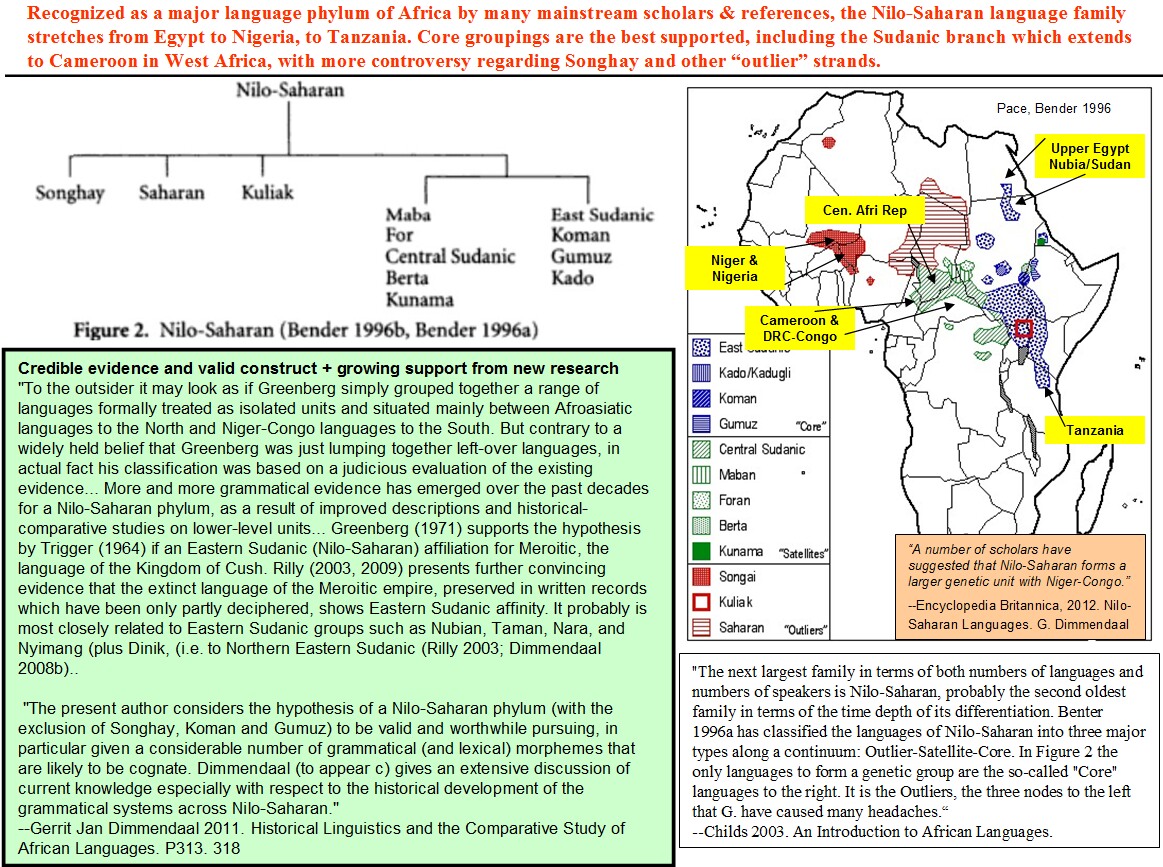 "Indeed, this view seems to be widespread in particular among non-specialists. But it is not clear what this skepticism is based upon. There nay in fact be a psychological reason for this. To the outsider it may look as if Greenberg simply grouped together a range of languages formally treated as isolated units and situated mainly between Afroasiatic languages to the North and Niger-Congo languages to the South. But contrary to a widely held belief that Greenberg was just lumping together left-over languages, in actual fact his classification was based on a judicious evaluation of the existing evidence... More and more grammatical evidence has emerged over the past decades for a Nilo-Saharan phylum, as a result of improved descriptions and historical-comparative studies on lower-level units... Greenberg (1971) supports the hypothesis by Trigger (1964) if an Eastern Sudanic (Nilo-Saharan) affiliation for Meroitic, the language of the Kingdom of Cush. Rilly (2003, 2009) presents further convincing evidence that the extinct language of the Meroitic empire, preserved in written records which have been only partly deciphered, shows Eastern Sudanic affinity. It probably is most closely related to Eastern Sudanic groups such as Nubian, Taman, Nara, and Nyimang (plus Dinik, (i.e. to Northern Eastern Sudanic (Rilly 2003; Dimmendaal 2008b).. " --Gerrit Jan Dimmendaal 2011. Historical Linguistics and the Comparative Study of African Languages. p313. "Nevertheless,, Ehret (2001) is to be complimented for putting together and comparing so many grammatical morphemes found in different Nilo-Saharan groups. Moreover, 'the Nilo-Saharan Etymological Dictionary' that forms the bulk of Ehret's text is a fertile source of suggestions for iso-glosses that can be more carefully worked out by other writers with more mainstream views about semantics and referencing previous work' as Blench (2000:303) put it. The present author considers the hypothesis of a Nilo-Saharan phylum (with the exclusion of Songhay, Koman and Gumuz) to be valid and worthwhile pursuing, in particular given a considerable number of grammatical (and lexical) morphemes that are likely to be cognate. Dimmendaal (to appear c) gives an extensive discussion of current knowledge especially with respect to the historical development of the grammatical systems across Nilo-Saharan." --Dimmendaal 2011. p 318 "Whereas research over the past decades has resulted in additional historical comparative evidence becoming available in favor of Greenberg's hypotheses on Niger-Congo, and a Nilo-Saharan as well as an Afroasiatic phylum.." --Dimmendaal 2011. p 324 "The next largest family in terms of both numbers of languages and numbers of speakers is Nilo-Saharan, probably the second oldest family in terms of the time depth of its differentiation. Benter 1996a has classified the languages of Nilo-Saharan into three major types along a continuum: Outlier-Satellite-Core. In Figure 2 the only languages to form a genetic group are the so-called "Core" languages to the right. It is the Outliers, the three nodes to the left that G. have caused many headaches.“ --Childs 2003. An Introduction to African Languages. “A number of scholars have suggested that Nilo-Saharan forms a larger genetic unit with Niger-Congo.” --Encyclopedia Britannica, 2012. Nilo-Saharan Languages. G. Dimmendaal www.britannica.com/topic/Nilo-Saharan-languages-------------------------- Note: Some scholars say Songhay and Saharan is a part of Nilo-Saharan. Above the most common seeming view in the lit is given. But in any event many credible scholars see Nilo-Saharan as a valid phylum and/or hypothesis based on careful work, with the major core parts such as the Sudanic branches which stretch from Nubia to Cameroon drawing the most solid support. More arguments and debates surround specific parts and pieces that may or may not fit. But the cores seem to reflect the bulk of the support in most standard references and peer reviewed articles (See Dimmendaal 2008 for example). New research is continually adding more support to the field.
|
|
|
|
Post by zarahan on Oct 16, 2015 20:03:01 GMT -5
NORTH AFRICAN DATA
Several North African archaelogical finds indicate variation within a common African foundation
North Africa is quickly emerging as one of the more important regions yielding information on the origins of modern Homo sapiens. Associated with significant fossil hominin remains are two stone tool industries, the Aterian and Mousterian, which have been differentiated, respectively, primarily on the basis of the presence and absence of tanged, or stemmed, stone tools. Largely because of historical reasons, these two industries have been attributed to the western Eurasian Middle Paleolithic rather than the African Middle Stone Age. In this paper, drawing on our recent excavation of Contrebandiers Cave and other published data, we show that, aside from the presence or absence of tanged pieces, there are no other distinctions between these two industries in terms of either lithic attributes or chronology. Together, these results demonstrate that these two ‘industries’ are instead variants of the same entity. Moreover, several additional characteristics of these assemblages, such as distinctive stone implements and the manufacture and use of bone tools and possible shell ornaments, suggest a closer affinity to other Late Pleistocene African Middle Stone Age industries rather than to the Middle Paleolithic of western Eurasia.
--Harold Dibble et al (2013). On the industrial attributions of the Aterian and Mousterian of the Maghreb, Xl. Journal of Human Evolution, 2013 Elsevier.
------------------------------------------------------------------
Barbed bone point and fishing culture appear at many points in Africa, often linked with ceramics, suggesting a common ancient African tradition existing long before so-called sub-Saharan boundaries
"Examination of African barbed bone points recovered from Holocene sites provides a context to interpret three Late Pleistocene occurrences from Katanda and Ishango, Zaire, and White Paintings Shelter, Botswana. In sites dated to ca. 10,000 BP and younger, such artifacts are found widely distributed across the Sahara Desert, the Sahel, the Nile, and the East African Lakes. They are present in both ceramic and aceramic contexts, sometimes associated with domesticates. The almost-universal presence of fish remains indicates a subsistence adaptation which incorporates a riverine/lacustrine component. Typologically these points exhibit sufficient similarity in form and method of manufacture to be subsumed within a single African “tradition.” They are absent at Fayum, where a distinct Natufian form occurs. Specimens dating to ca. 20,000 BP at Ishango, possibly a similar age at White Paintings Shelter, and up to 90,000 BP at Katanda clearly fall within this same African tradition and thus indicate a very long-term continuity which crosses traditionally conceived sub-Saharan cultural boundaries."
-John E. Yellen, Barbed Bone Points: Tradition and Continuity in Saharan and Sub-Saharan Africa. African Archaeological Review September 1998, Volume 15, Issue 3, pp 173-198
------------------------------------------------------------------
North African Taforalt and Afalou skeletal samples of African origin, and indicate presence of African cultural traditions such as incisor removal
"The extremely large skeletal samples that come from sites such as Taforalt (Fig. 8.13) and Afalou constitute an invaluable resource for understanding the makers of Iberomaurusian artifacts, and their number is unparalleled elsewhere in Africa for the early Holocene. Frequently termed Mechta-Afalou or Mechtoid, these were a skeletally robust people and definitely African in origin, though attempts, such as those of Ferembach (1985), to establish similarities with much older and rarer Aterian skeletal remains are tenuous given the immense temporal separation between the two (Close and Wendorf 1990). At the opposite end of the chronological spectrum, dental morphology does suggest connections with later Africans, including those responsible for the Capsian Industry (Irish 2000) and early mid-Holocene human remains from the western half of the Sahara (Dutour 1989), something that points to the Maghreb as one of the regions from which people recolonised the desert (MacDonald 1998)... the individuals from Taforalt, the largest sample by far, display little evidence of trauma, though they do suggest a high incidence of infant mortality, with evidence for dental caries, arthritis, and rheumatism among other degenerative conditions. Interestingly, Taforalt also provides one of the oldest known instances of the practice of trepanation, the surgical removal of a portion of the cranium; the patient evidently survived for some time, as there are signs of bone regrowth in the affected area. Another form of body modification was much more widespread and, indeed, a distinctive feature of the Iberomaurusian skeletal sample as a whole. This was the practice of removing two or more of the upper incisors, usually around puberty and from both males and females, something that probably served as both a rite of passage and an ethnic marker (Close and Wendorf 1990), just as it does in parts of sub-Saharan Africa today (e.g., van Reenen 1987)."
--Lawrence Barham. (2008) The First Africans: African Archaeology from the Earliest Toolmakers to Most Recent Foragers (Cambridge World Archaeology)
-----------------------------------------------------------------------------------------------
Archaeological data from Southern Egypt linked with a broad cross-cutting range of hunting and fishing populations exteding all th way to the Congo and North Africa
QUOTE:
“It is also similar to that of other desert-adapted or even savannah-adapted populations of Upper Paleolithic to modern times in the range from Morrocco and Egypt to the lake country of East Africa.”
“The proper comparisons would be with the hunting and fishing populations between 20,000 and 8,000 B.P., along and between the Nile drainage, from the mountains and forested terrain of Zaire to the savannah lake country. Northwards, toward the Delta (actual Nile Delta sites obviously are very deeply buried) and finally with the chain of North African populations.”
“If we had Upper Paleolithic to early Mesolithic samples from Egypt, Libya and the northern Sahara, we would probably find a smooth transition from the Ishango-Lothagam-Elementeita proto-Nilotics to the Mecha-Afalou proto- Moors and proto-Berbers.”
“The Wadi Kubbaniya skeleton is a link in a chain of hunting and fishing peoples present in Africa, from 20,000 B.P. to 8,000 B.P. They are the direct ancestors of modern Nilotics, Nubians, Egyptians, probably Libyans and Berbers.”
FROM: --J. Lawrence Angel and Jennifer Olsen Kelley (1986)]The Wadi Kubbaniya Skeleton: A Late Paleolithic Burial from Southern Egypt Description and comparison of the skeleton
|
|

![]() i58.tinypic.com/2nle1yc.jpg/IMG]
i58.tinypic.com/2nle1yc.jpg/IMG]




















:format(jpeg):mode_rgb()/discogs-images/R-766835-1160674026.jpeg.jpg)















